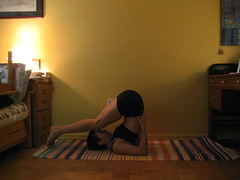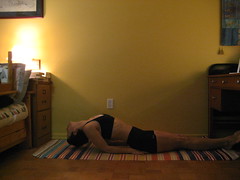The weather warmed up considerably yesterday. The high was 14C, which melted most of the snow in the park (it's truly magical how *fast* it melts). The roads are all fine.
A few weeks ago, a reader asked about the modified closing sequence I sometimes use in my practice. Over the past 9 months, I've sort of developed a 'philosophy' about the closing sequence and it's shaped how I approach this poses in my own practice and how I teach them.
For all intents and purposes - or *my* purposes, at least - the closing sequence is a cool-down. It should be relaxing or, at least, not overly taxing. I never skip closing, but I often cut myself some slack if I'm feeling tired or over-stimulated from the Primary Series. By taking it easy during my closing sequence, I find that it's easier to relax in Savasana.
The first thing I do to ease the intensity of the closing sequence is skip some of the vinyasas between poses. I usually do only two or three vinyasas, just enough to keep my body warm. I also soften and deepen my Ujjayi breathing. If I can't manage to focus on breath during the rest of the practice, I should at the very least be doing it during these poses (it's good practice!).
Depending on how I'm feeling - and by that I mean how my back and neck are feeling - I will sometimes modify the sequence further. When I'm feeling really under-the-weather or I'm on the verge of a Ladies Holiday, I'll even throw in the towel and do Viparita Karani for 10 minutes.
I'm not hard-core when it comes to closing and this is why: When you take away the shalas and the teachers and other students and your own judgement and expectations, this is YOUR practice. And the closing sequence should feel good, nourishing and prepare you to take your practice off the mat and into your world - whatever this means to you. You shouldn't dread your sequence and you shouldn't feel rotten after your practise. If you do, you need to take it down a notch or two.
So explore different modifications until you find the sequence that brings you ease. In time, the full closing sequence will do this for you, but don't beat yourself up over getting all of the details of shoulderstand perfectly when you're just beginning an Ashtanga yoga practice. Do what you can, learn the dristes and BREATHE!
What follows is the basic sequence that I teach my beginning Ashtanga students. This gives them a sense of the sequence and some of its benefits without the full postures (which none of my beginners can generally do).
1) Paschimottanasana (forward bend): The forward bend is an important counterpose to backbends, even if you're not practising the full expression of Urdhva Dhanurasana. Even the prep poses for backbends can stimulate the nervous system. Forward bends bring the body back into equilibrium.
2) Ardha Sarvangasana (half shoulderstand): I love this variation because almost everyone can do it, it places minimal stress on the neck and back and it feels comfy for most people. Starting on your back, roll backwards, swinging your legs up and bringing your hands to the sacrum (the flat area just below the low back) to support your body. Hold this 5-10 breaths.

3) Ardha Karna Pidasana (half squeeze-the-ears pose): Next, bring the legs back further and gently rest the knees near the forehead. The bend in the knees should allow most people - even those with cranky low backs or tight hamstrings - to do this pose. This is a nice preparation for Halasana. Hold for 5 breaths.

4) Ardha Matsyasana (half fish): This pose is mostly a chest lift and can be practised with the chin tucked toward the chest if your neck is sensitive. If your neck feels good, you can very gently drop you head back. At no time is the full weight of the body resting on the head - the weight of the body is supported by the arms. Hold for 3 to 5 breaths.

5) Sasangasana (rabbit pose): This pose is not a traditional part of the closing sequence - I add it because it offers some gentle shoulder-opening (which comes from the shoulderstand cycle in the traditional closing sequence) and introduces some gentle pressure on the crown of the head in preparation for Sirsasana. Hold for 3 to 5 breaths.

6) Ardha Sirsasana (half headstand): In this headstand variation, the emphasis should be on the strength of the arms and shoulders. The crown of the head should barely be touching the mat. Hold for 5 to 10 breaths.

7) Padmasana: This pose can be practised in simple cross-legged position, half-lotus or full-lotus. Hold for 10 breaths.
6 comments:
I love you
Hi Kaivalya,
I really enjoy reading your blog. Wondering if riding a bike every day doesn't tighten hamstrings too much for yoga practice? I want to ride again and do other things for that matter but all I keep thinking is after all my work getting flexible, especially hamstrings, that I will get tight again riding.
Any suggestions?
Thank you!
Anon in NYC
Thank you for this nice closing sequence. The pictures are beautiful, too.
Surya and Rachelle: Glad you found the closing sequence useful! :-)
Anonymous: Cycling has never tightened my hams, but it *does* noticeably tighten my hip flexors. When I stop biking in the winter, my hips almost immediately go back to their previous level of flexibility, though.
I used to be a serious runner and found that this, more than anything else, tightened my hams. It wasn't until I quit running (because of problems with my knees), that I finally started making progress in my forward bends, down dog and Halasana.
My best suggestion for cycling (and any other sport or activity) is to keep doing yoga! And listen to your body, being patient with the changes in flexibility that come up - and remaining mindful of your own capacities.
There's a 'three steps forward, two steps back' process that often happens in a personal yoga practice. It never helps to be judgmental of that process or to avoid activities (particularly fun activities like cycling) trying to subvert it.
Thank you for taking the time to give me these details :) Very appreciated. Gonna start riding my bike again with all this in mind.
Blessings,
Anon in NYC
Post a Comment